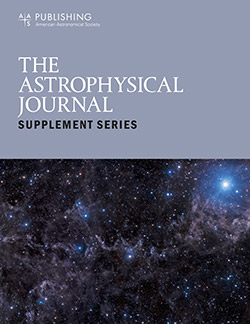An R V Map of the Milky Way Revealed by LAMOST
IF 8.5
1区 物理与天体物理
Q1 ASTRONOMY & ASTROPHYSICS
引用次数: 1
Abstract
Abstract The total-to-selective extinction ratio, R V , is a key parameter for tracing the properties of interstellar dust, as it directly determines the variation of the extinction curve with wavelength. By utilizing accurate color excess measurements from the optical to the mid-infrared range, we have derived R V values for approximately three million stars from LAMOST data release 7 using a forward-modeling technique. This extensive data set enables us to construct a comprehensive 2D R V map of the Milky Way within the LAMOST footprint at a spatial resolution of ∼27.′5. Based on reliable sight lines of E ( B − V ) > 0.1, we find that R V exhibits a Gaussian distribution centered around 3.25 with a standard deviation of 0.25. The spatial variability of R V in the Galactic disk exhibits a wide range, spanning from small scales within individual molecular clouds to large scales up to kiloparsecs. A striking correlation is observed between the distribution of R V and molecular clouds. Notably, we observe lower R V values within the regions of nearby molecular clouds compared to their surrounding areas. Furthermore, we have investigated the relationships between R V and various parameters, including dust temperature, dust emissivity spectral index, column densities and ratios of atomic and molecular hydrogen, as well as the gas-to-dust ratio. We find that these relationships vary with the level of extinction. These analyses provide new insights into the properties and evolution of dust grains in diverse interstellar environments and also hold significant importance for achieving accurate extinction corrections.LAMOST揭示的银河系R - V图
总选择性消光比R V直接决定了消光曲线随波长的变化,是追踪星际尘埃性质的关键参数。通过利用光学到中红外范围的精确颜色过剩测量,我们使用前向建模技术从LAMOST数据发布7中获得了大约300万颗恒星的R V值。这个广泛的数据集使我们能够在LAMOST足迹内以~ 27.5的空间分辨率构建银河系的全面二维R - V地图。基于可靠的E (B−V) >0.1时,我们发现R V呈以3.25为中心的高斯分布,标准差为0.25。星系盘中R - V的空间变异性表现出很大的范围,从单个分子云的小尺度到千秒差距的大尺度。在rv的分布和分子云之间观察到显著的相关性。值得注意的是,我们观察到附近分子云区域内的R V值比周围区域低。此外,我们还研究了R V与各种参数的关系,包括尘埃温度、尘埃发射率光谱指数、柱密度、原子氢和分子氢的比以及气尘比。我们发现,这些关系随着物种灭绝的程度而变化。这些分析为了解不同星际环境中尘埃颗粒的性质和演化提供了新的见解,对于实现精确的消光校正也具有重要意义。
本文章由计算机程序翻译,如有差异,请以英文原文为准。
求助全文
约1分钟内获得全文
求助全文
来源期刊

Astrophysical Journal Supplement Series
地学天文-天文与天体物理
CiteScore
14.50
自引率
5.70%
发文量
264
审稿时长
2 months
期刊介绍:
The Astrophysical Journal Supplement (ApJS) serves as an open-access journal that publishes significant articles featuring extensive data or calculations in the field of astrophysics. It also facilitates Special Issues, presenting thematically related papers simultaneously in a single volume.
 求助内容:
求助内容: 应助结果提醒方式:
应助结果提醒方式:


